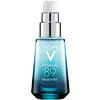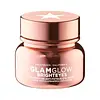What's inside
What's inside
 Key Ingredients
Key Ingredients

 Benefits
Benefits

 Concerns
Concerns

 Ingredients Side-by-side
Ingredients Side-by-side

Water
Skin ConditioningButyrospermum Parkii Butter
Skin ConditioningButylene Glycol
HumectantDimethicone
EmollientGlycerin
HumectantCetearyl Alcohol
EmollientCetyl Esters
EmollientIsostearyl Neopentanoate
EmollientCetyl Alcohol
EmollientPolybutene
Sodium Hyaluronate
HumectantCaffeine
Skin ConditioningTocopheryl Acetate
AntioxidantNarcissus Tazetta Bulb Extract
AstringentAminopropyl Ascorbyl Phosphate
AntioxidantLinoleic Acid
CleansingAcetyl Hexapeptide-8
HumectantArtemia Extract
Skin ConditioningHibiscus Sabdariffa Flower Extract
Skin ConditioningTrifluoroacetyl Tripeptide-2
Skin ConditioningAnthemis Nobilis Flower Extract
MaskingLaminaria Digitata Extract
Skin ProtectingCucumis Melo Fruit Extract
Skin ConditioningCetearyl Glucoside
EmulsifyingCholesterol
EmollientPersea Gratissima Oil
Skin ConditioningPyrus Malus Fruit Extract
Skin ConditioningLens Esculenta Fruit Extract
Skin ConditioningCitrullus Lanatus Fruit Extract
Skin ConditioningAlgae Extract
EmollientLauryl PCA
HumectantLactis Proteinum
Skin ConditioningYeast Extract
Skin ConditioningSodium Lactate
BufferingSorbitol
HumectantTrehalose
HumectantZinc PCA
HumectantGlucose
HumectantAcetyl Glucosamine
Skin ConditioningNeopentyl Glycol Diheptanoate
EmollientCarbomer
Emulsion StabilisingSodium Hydroxide
BufferingPropylene Glycol Dicaprylate
EmollientPolymethyl Methacrylate
Sodium PCA
HumectantDextran
Acrylates/C10-30 Alkyl Acrylate Crosspolymer
Emulsion StabilisingPolyethylene
AbrasiveDecarboxy Carnosine Hcl
Skin ConditioningPotassium Sulfate
Caprylyl Glycol
Emollient1,2-Hexanediol
Skin ConditioningTetradecyl Aminobutyroylvalylaminobutyric Urea Trifluoroacetate
Skin ConditioningMethyl Glucose Sesquistearate
EmollientBHT
AntioxidantDisodium EDTA
Phenoxyethanol
PreservativePotassium Sorbate
PreservativeSodium Benzoate
MaskingMica
Cosmetic ColorantCI 77891
Cosmetic ColorantCI 77491
Cosmetic ColorantWater, Butyrospermum Parkii Butter, Butylene Glycol, Dimethicone, Glycerin, Cetearyl Alcohol, Cetyl Esters, Isostearyl Neopentanoate, Cetyl Alcohol, Polybutene, Sodium Hyaluronate, Caffeine, Tocopheryl Acetate, Narcissus Tazetta Bulb Extract, Aminopropyl Ascorbyl Phosphate, Linoleic Acid, Acetyl Hexapeptide-8, Artemia Extract, Hibiscus Sabdariffa Flower Extract, Trifluoroacetyl Tripeptide-2, Anthemis Nobilis Flower Extract, Laminaria Digitata Extract, Cucumis Melo Fruit Extract, Cetearyl Glucoside, Cholesterol, Persea Gratissima Oil, Pyrus Malus Fruit Extract, Lens Esculenta Fruit Extract, Citrullus Lanatus Fruit Extract, Algae Extract, Lauryl PCA, Lactis Proteinum, Yeast Extract, Sodium Lactate, Sorbitol, Trehalose, Zinc PCA, Glucose, Acetyl Glucosamine, Neopentyl Glycol Diheptanoate, Carbomer, Sodium Hydroxide, Propylene Glycol Dicaprylate, Polymethyl Methacrylate, Sodium PCA, Dextran, Acrylates/C10-30 Alkyl Acrylate Crosspolymer, Polyethylene, Decarboxy Carnosine Hcl, Potassium Sulfate, Caprylyl Glycol, 1,2-Hexanediol, Tetradecyl Aminobutyroylvalylaminobutyric Urea Trifluoroacetate, Methyl Glucose Sesquistearate, BHT, Disodium EDTA, Phenoxyethanol, Potassium Sorbate, Sodium Benzoate, Mica, CI 77891, CI 77491
 Reviews
Reviews

Ingredients Explained
These ingredients are found in both products.
Ingredients higher up in an ingredient list are typically present in a larger amount.
This ingredient is also known as shea butter. It is an effective skin hydrator and emollient.
Emollients help soothe and soften your skin. It does this by creating a protective film on your skin. This barrier helps trap moisture and keeps your skin hydrated. Emollients may be effective at treating dry or itchy skin.
Shea butter is rich in antioxidants. Antioxidants help fight free-radicals, or molecules that may harm the body. It is also full of fatty acids including stearic acid and linoleic acid. These acids help replenish the skin and keep skin moisturized.
While Shea Butter has an SPF rating of about 3-4, it is not a sunscreen replacement.
Shea butter may not be fungal acne safe. We recommend speaking with a professional if you have any concerns.
Learn more about Butyrospermum Parkii ButterCaffeine is most associated with coffee, tea, and cacao. In skincare, it helps with calming inflammation and is rich in antioxidants.
While caffeine is used to treat cellulite and and dark circles, further studies are needed to prove this. It has been believed to help with these skin conditions due to its ability to dilate blood vessels and increase blood flow.
Some studies are looking into caffeine's ability to protect against UV rays.
Learn more about CaffeineCaprylyl Glycol is a humectant and emollient, meaning it attracts and preserves moisture.
It is a common ingredient in many products, especially those designed to hydrate skin. The primary benefits are retaining moisture, skin softening, and promoting a healthy skin barrier.
Though Caprylyl Glycol is an alcohol derived from fatty acids, it is not the kind that can dry out skin.
This ingredient is also used as a preservative to extend the life of products. It has slight antimicrobial properties.
Learn more about Caprylyl GlycolCarbomer is a polymer of acrylic acid. Its main role is to create a gel consistency.
A high amount of carbomer can cause pilling or balling up of products. Don't worry, most products contain 1% or less of carbomer.
Glycerin is already naturally found in your skin. It helps moisturize and protect your skin.
A study from 2016 found glycerin to be more effective as a humectant than AHAs and hyaluronic acid.
As a humectant, it helps the skin stay hydrated by pulling moisture to your skin. The low molecular weight of glycerin allows it to pull moisture into the deeper layers of your skin.
Hydrated skin improves your skin barrier; Your skin barrier helps protect against irritants and bacteria.
Glycerin has also been found to have antimicrobial and antiviral properties. Due to these properties, glycerin is often used in wound and burn treatments.
In cosmetics, glycerin is usually derived from plants such as soybean or palm. However, it can also be sourced from animals, such as tallow or animal fat.
This ingredient is organic, colorless, odorless, and non-toxic.
Glycerin is the name for this ingredient in American English. British English uses Glycerol/Glycerine.
Learn more about GlycerinPhenoxyethanol is a preservative that has germicide, antimicrobial, and aromatic properties. Studies show that phenoxyethanol can prevent microbial growth. By itself, it has a scent that is similar to that of a rose.
It's often used in formulations along with Caprylyl Glycol to preserve the shelf life of products.
Sodium Hyaluronate is hyaluronic acid's salt form. It is commonly derived from the sodium salt of hyaluronic acid.
Like hyaluronic acid, it is great at holding water and acts as a humectant. This makes it a great skin hydrating ingredient.
Sodium Hyaluronate is naturally occurring in our bodies and is mostly found in eye fluid and joints.
These are some other common types of Hyaluronic Acid:
Learn more about Sodium HyaluronateWater. It's the most common cosmetic ingredient of all. You'll usually see it at the top of ingredient lists, meaning that it makes up the largest part of the product.
So why is it so popular? Water most often acts as a solvent - this means that it helps dissolve other ingredients into the formulation.
You'll also recognize water as that liquid we all need to stay alive. If you see this, drink a glass of water. Stay hydrated!
Learn more about Water